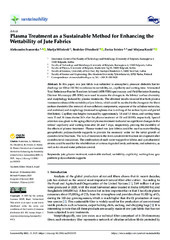Приказ основних података о документу
Plasma Treatment as a Sustainable Method for Enhancing the Wettability of Jute Fabrics
| dc.creator | Ivanovska, Aleksandra | |
| dc.creator | Milošević, Marija | |
| dc.creator | Obradović, Bratislav | |
| dc.creator | Svirčev, Zorica | |
| dc.creator | Kostić, Mirjana | |
| dc.date.accessioned | 2023-02-23T12:12:59Z | |
| dc.date.available | 2023-02-23T12:12:59Z | |
| dc.date.issued | 2023 | |
| dc.identifier.issn | 2071-1050 | |
| dc.identifier.uri | http://TechnoRep.tmf.bg.ac.rs/handle/123456789/5868 | |
| dc.description.abstract | In this paper, raw jute fabric was subjected to atmospheric pressure dielectric barrier discharge (at 150 or 300 Hz) to enhance its wettability, i.e., capillarity and wetting time. Attenuated Total Reflectance-Fourier Transform Infrared (ATR-FTIR) spectroscopy and Field Emission Scanning Electron Microscopy (FE-SEM) were used to assess the changes in the fabrics’ surface chemistry and morphology induced by plasma treatments. The obtained results revealed that both plasma treatments enhanced the wettability of jute fabrics, which could be ascribed to the changes in the fibers’ surface chemistry (the removal of non-cellulosic components, exposure of the cellulose molecules, and oxidation) and morphology (increased roughness due to etching of the surface layers and partial fibrillation). Capillary rise heights increased by approximately 1.8 and 1.9 times, and wetting times were 35 and 34 times shorter 24 h after the plasma treatment at 150 and 300 Hz, respectively. Special attention was given to the aging effect of plasma treatment indicated no significant changes in the fabrics’ capillarity and wetting time after 28 and 7 days, respectively, proving the durability of the effects of plasma treatment. Plasma-treated raw jute fabrics could be used as water-binding geo-prebiotic polysaccharide supports to provide the necessary water for the initial growth of cyanobacterial biocrusts. The lack of moisture is the main constraint in biocrust development after cyanobacterial inoculation. The combination of such water-supportive fabrics and cyanobacterial strains could be used for the rehabilitation of various degraded lands, sediments, and substrates, as well as for air and water pollution control. | sr |
| dc.language.iso | en | sr |
| dc.publisher | MDPI | sr |
| dc.relation | info:eu-repo/grantAgreement/ScienceFundRS/Ideje/7726976/RS// | sr |
| dc.rights | openAccess | sr |
| dc.rights.uri | https://creativecommons.org/licenses/by/4.0/ | |
| dc.source | Sustainability (Switzerland) | sr |
| dc.subject | capillarity | sr |
| dc.subject | geo-prebiotic polysaccharide supports | sr |
| dc.subject | jute | sr |
| dc.subject | plasma treatment | sr |
| dc.subject | sustainable method | sr |
| dc.subject | wettability | sr |
| dc.subject | wetting time | sr |
| dc.title | Plasma Treatment as a Sustainable Method for Enhancing the Wettability of Jute Fabrics | sr |
| dc.type | article | sr |
| dc.rights.license | BY | sr |
| dc.citation.issue | 3 | |
| dc.citation.rank | M22~ | |
| dc.citation.spage | 2125 | |
| dc.citation.volume | 15 | |
| dc.identifier.doi | 10.3390/su15032125 | |
| dc.identifier.fulltext | http://TechnoRep.tmf.bg.ac.rs/bitstream/id/15537/Plasma_Treatment_as_pub_2023.pdf | |
| dc.identifier.scopus | 2-s2.0-85147884133 | |
| dc.type.version | publishedVersion | sr |

